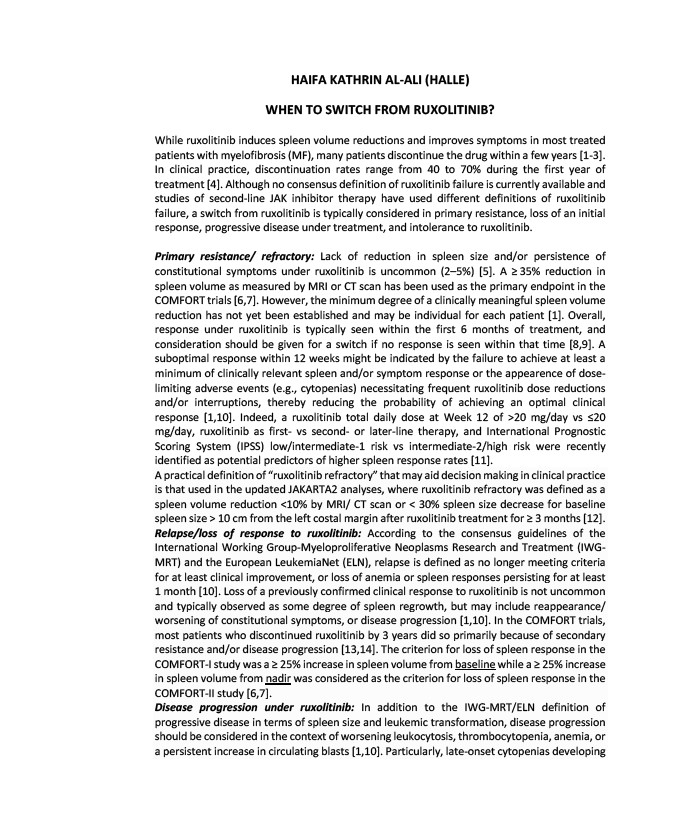
HAIFA KATHRIN AL-ALI (HALLE)
WHEN TO SWITCH FROM RUXOLITINIB?
While ruxolitinib induces spleen volume reductions and improves symptoms in most treated
patients with myelofibrosis (MF), many patients discontinue the drug within a few years 1-3.
In clinical practice, discontinuation rates range from 40 to 70% during the first year of
treatment 4. Although no consensus definition of ruxolitinib failure is currently available and
studies of second-line JAK inhibitor therapy have used different definitions of ruxolitinib
failure, a switch from ruxolitinib is typically considered in primary resistance, loss of an initial
response, progressive disease under treatment, and intolerance to ruxolitinib.
Primary resistance/ refractory: Lack of reduction in spleen size and/or persistence of
constitutional symptoms under ruxolitinib is uncommon (2–5%) 5. A ≥ 35% reduction in
spleen volume as measured by MRI or CT scan has been used as the primary endpoint in the
COMFORT trials 6,7. However, the minimum degree of a clinically meaningful spleen volume
reduction has not yet been established and may be individual for each patient 1. Overall,
response under ruxolitinib is typically seen within the first 6 months of treatment, and
consideration should be given for a switch if no response is seen within that time 8,9. A
suboptimal response within 12 weeks might be indicated by the failure to achieve at least a
minimum of clinically relevant spleen and/or symptom response or the appearence of dose-limiting
adverse events (e.g., cytopenias) necessitating frequent ruxolitinib dose reductions
and/or interruptions, thereby reducing the probability of achieving an optimal clinical
response 1,10. Indeed, a ruxolitinib total daily dose at Week 12 of >20 mg/day vs ≤20
mg/day, ruxolitinib as first- vs second- or later-line therapy, and International Prognostic
Scoring System (IPSS) low/intermediate-1 risk vs intermediate-2/high risk were recently
identified as potential predictors of higher spleen response rates 11.
A practical definition of “ruxolitinib refractory” that may aid decision making in clinical practice
is that used in the updated JAKARTA2 analyses, where ruxolitinib refractory was defined as a
spleen volume reduction <10% by MRI/ CT scan or < 30% spleen size decrease for baseline
spleen size > 10 cm from the left costal margin after ruxolitinib treatment for ≥ 3 months 12.
Relapse/loss of response to ruxolitinib: According to the consensus guidelines of the
International Working Group-Myeloproliferative Neoplasms Research and Treatment (IWG-MRT)
and the European LeukemiaNet (ELN), relapse is defined as no longer meeting criteria
for at least clinical improvement, or loss of anemia or spleen responses persisting for at least
1 month 10. Loss of a previously confirmed clinical response to ruxolitinib is not uncommon
and typically observed as some degree of spleen regrowth, but may include reappearance/
worsening of constitutional symptoms, or disease progression 1,10. In the COMFORT trials,
most patients who discontinued ruxolitinib by 3 years did so primarily because of secondary
resistance and/or disease progression 13,14. The criterion for loss of spleen response in the
COMFORT-I study was a ≥ 25% increase in spleen volume from baseline while a ≥ 25% increase
in spleen volume from nadir was considered as the criterion for loss of spleen response in the
COMFORT-II study 6,7.
Disease progression under ruxolitinib: In addition to the IWG-MRT/ELN definition of
progressive disease in terms of spleen size and leukemic transformation, disease progression
should be considered in the context of worsening leukocytosis, thrombocytopenia, anemia, or
a persistent increase in circulating blasts 1,10. Particularly, late-onset cytopenias developing